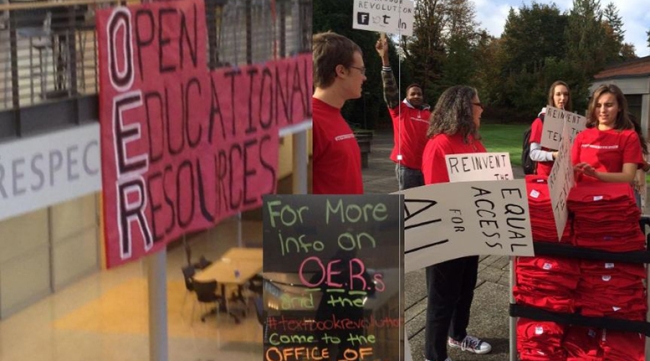You have /5 articles left.
Sign up for a free account or log in.

Students at Pierce College promote open educational resources.
Pierce College
LONG BEACH, Calif. -- The news releases regularly roll in to the email inbox these days with headlines like "College X has saved students $5 million by adopting open educational resources." Not only have these initiatives made a higher education more affordable, the colleges and universities note, but students who might have forgone buying an expensive textbook in the past are actually getting and using the OER content, ideally contributing to their academic success.
Amid those successes, rarely mentioned is the reality that in many cases, the institution itself is picking up the costs that were formally borne by the students, through some combination of direct subsidies to instructors to create the content and a loss of textbook revenue to a campus store, among other costs.
A session this week at the annual meeting of the National Association of College and University Business Officers addressed that issue head-on, in a way that would be unusual at a conference of OER advocates. It's not that the session took a skeptical view of OER -- far from it. The featured institution, the Pierce College District in Washington State, has fully embraced the use of open resources for affordability and efficacy, among other reasons. But the enthusiasm of the community college's open education project manager, Quill West, was balanced by the even-keeled acknowledgment of Choi Halladay, the district's vice president of administrative services, that OER comes at a price to the institution -- though a price very much worth paying, he said.
"We've done the math at our institution," Halladay said, noting the increased enrollments and credit hours derived from students who are less deterred by high textbook prices does not yet balance what Pierce spends on OER development and forfeits in lost textbook revenue.
"It does not 100 percent add up to a change in expenses and costs so far for us, but mitigates that expense and helps us meet our [educational] mission."
Unequivocal Support for OER
West is an OER booster, and she made a compelling case to the business officers in attendance about why the use of open educational resources is so good for Pierce's roughly 16,000 students, 62 percent of whom are first-generation college students and a quarter of whom are eligible for Pell Grants. In addition to students at its two campuses around Tacoma, the college has a remote outpost on a military base.
Like many community college students, Pierce's fund much of their education themselves, and the cost of curricular materials is a major burden -- often leading them not to buy the required materials. To date the college has implemented open educational resources in about a tenth of its courses, West estimated.
Over three years, she said, more than 23,000 students took courses built on entirely free educational resources, saving them an estimated $2 million. (Pierce's estimates, like those typically offered by colleges, are derived by calculating the average price of the books that the OER replaced, multiplied by the number of students served.)
West said Pierce is working with the national organization Achieving the Dream to measure the educational impact of OER (in terms of increased academic success rates, for instance), but that the data aren't yet available. Early data show, though, that students drop OER courses at lower rates than other classes at Pierce. (She also described the use of open educational resources as being a game-changer from a faculty development standpoint, in terms of engaging instructors in new kinds of course and curriculum development.
West was straightforward in describing what Pierce is doing in embracing OER: "We transfer the costs of educational services from students onto the institution," bearing a "pretty significant cost" in creating and maintaining the open materials.
Doing the Math
Obviously Pierce is not picking up the $2 million that it estimates students are saving; after all, one of the whole points of OER is that the materials are less expensive to produce as well as to use.
But the embrace of OER has resulted in "several hundreds of thousands of dollars less" in textbook revenue, Halladay said. Also losing out is the campus bookstore, which in Pierce's case is Barnes & Noble.
"It very radically changes your relationship with the bookstore when you're doing something very directly that's going to purposely cut their revenue," he said.
To the bookstore company's credit, Halladay said, "they have been very supportive of us in this." (He noted that bookstore revenue had been steadily declining in recent years anyway.)
The other major budget hit taken on by Pierce in wide adoption of OER is in stipends ($1,500) to instructors to develop open courses and materials. Like most colleges, Pierce recognizes that creating a new curriculum using open educational materials takes significant time and effort to either hunt down or create such materials, and that many time-starved professors need incentives.
On the other side of the ledger, Halladay said, are the educational benefits to students, some of which can accrue to the institution's bottom line.
Daunted by the high price of traditional course materials, "many students choose either bad outcomes -- not buying a textbook and getting a C out of this course -- or they don’t attend or they choose a lighter course load because of textbook expense," he said.
Halladay, too, is gathering data on Pierce's return on investment in OER for Achieving the Dream and said he was unable to share the findings just yet. But the ledger on the plus side includes the revenue from students who enroll when they wouldn't otherwise have done so, or who are taking more courses than they would have. Students who enroll full-time are also much more cost-effective for a college, he said, because they require the same amount of advising and other services that their part-time peers do, but contribute more revenue.
Still, if the goal is to make OER work in the long term because it produces enough revenue, or savings, to offset the cost of the institution's contributions, Halladay acknowledged that Pierce has not "figured out sustainability 100 percent of the way so far."
He hopes Pierce will see the same kind of enrollment bump that peers such as Tidewater Community College have experienced, which would go a long way toward producing revenue to sustain OER. If not, the college may need to consider an OER course fee, which, while not "free," would "still end up being a much lower burden to students."









